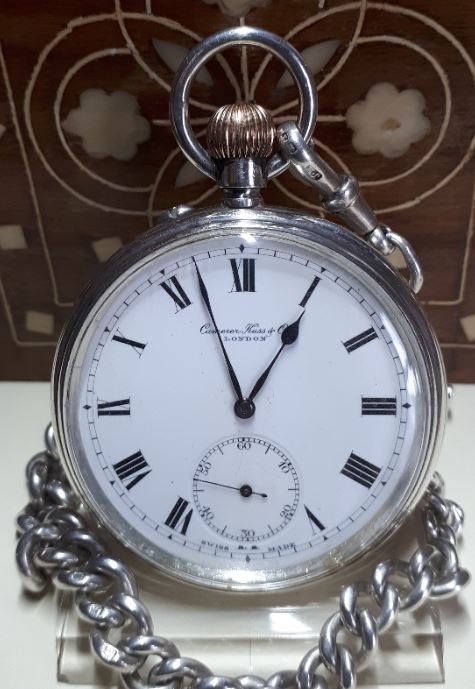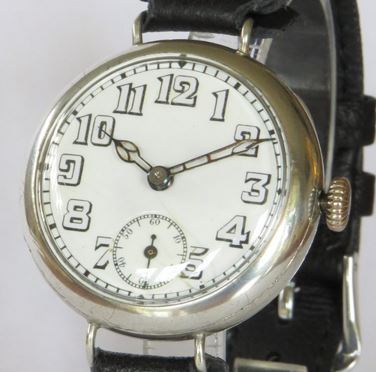Last updated on May 24, 2024
To a watchmaker, perhaps the most interesting part of a watch is the movement. However, to the owner, it will most certainly be the dial. The dial gives the watch its function, which is to display the time. In this post, we will take a look at how the typical antique watch dial was made. The methods will apply to antique pocket watches and trench watches. Although we won’t go into any detail in this post, some dials, such as those in Roskopf watches were made from paper.
Metal dials
Originally, watch dials were made of metal. However, when vitreous enamel became available during the eighteenth century, it quickly became the favoured material. The enamel was fused to an underlying metal plate, which was usually copper. Vitreous enamel has many useful properties. It is smooth, hard, and resistant to chemical stains. Additionally, it is durable, scratch-resistant (5–6 on the Mohs scale) and has long-lasting colour fastness. It is easy to clean, and cannot burn. Enamel is glass, not paint, so it does not fade under ultraviolet light. One disadvantage of enamel is a tendency to crack or shatter when the underlying metal is stressed or bent.
In contrast, metal dials with painted finishes will bend without problems. However, the dial surface is very delicate. It frequently deteriorates over time with discolouring or flaking. In addition, the delicate paint or lacquer finish can be destroyed by even gentle cleaning. In comparison, vitreous enamel dials are incredibly durable. They will happily go through a hot wash and look almost new. However, they can easily be cracked if even slightly bent. It is important to understand how dials were made and which type of dial you are dealing with. This is because it affects how they can be cleaned or restored. All of the watches in my collection have enamel dials, so I focus on them and exclude metal dials from the remainder of this post.
Enamel dials
Enamel is a glassy substance. It is usually opaque and applied by fusion to the surface of the metal, pottery, etc., as an ornament or for protection. The type of enamel used for watch dials is vitreous enamel, which is made from powdered glass. Vitreous enamel dials have a very hard surface which is usually shiny and reflective like glass. However, the surface can be made matt by rubbing with an abrasive after firing. Tin oxide is added to the vitreous enamel to make it opaque white, with other chemicals used for different colours. For example, adding cobalt produces a blue colour, chromium a green, iron a grey, and iodine a red.
To make a dial the enamel is fused onto a metal dial plate. This is achieved by firing in an oven at a high temperature, around 800 degrees Celsius. This melts the glass and causes it to run together to produce a smooth glassy surface over the metal plate. First, the overall white or black background is laid. This might take several rounds of firing and smoothing to get the desired finish. The enamel will be applied to both sides of the dial to ensure that it maintains consistent tension.
Markers
Next, the hour, minute and second markers are drawn on the dial using enamel ink. This is then fired, at a lower temperature, to fix it to the background. This melts the enamel of the markers and bonds them to the base layer of enamel. In addition, any branding, such as a retailer’s name, would be added in the same manner. The markings and branding become as much a part of the dial as the underlying enamel and cannot be removed. It is also very hard-wearing. As a result, antique watch dials can remain remarkably crisp despite their age.
Originally, the markers would have been painted by hand. However, it was impractical, slow and error-prone. Stamps were developed using an engraved copper block. The engravings were filled with enamel ink and stamped onto the dial. In this way, many dials could be made accurately, quickly and without error.
Enamel paint
Enamel paint is a totally different material from vitreous enamel. It is a paint that air-dries to a hard, usually glossy finish. Typically, it is used for coating hard-wearing surfaces that are outdoors or exposed to variations in temperature. It is called enamel because it forms a harder, glossier, surface than other paints such as oil paint. However, enamel paint is not as durable as the vitreous enamel on the dial itself. Unlike vitreous enamel, enamel paint can be easily dissolved by solvents. It also tends to fade and flake over time.
Unlike the fired vitreous ink, enamel paint doesn’t bond to the underlying vitreous enamel. It remains on its surface. It can usually be easily distinguished from the fired numbers by looking across the dial with a loupe. The enamel paint will be clearly seen standing above the surface of the dial. Additionally, because the vitreous enamel of the dial is very smooth, the enamel paint has difficulty adhering to it. Over time, the markings and brandings in enamel paint will become badly worn or perhaps disappear altogether. Using this method, it is not unusual to see antique pocket watches with the retailer’s name on the dial partially eroded away.
Luminous paint
Luminous paint is something that is also found on watch dials, most notably on trench watches. A luminous dial on a trench watch was essential for the officers in the trenches. The war didn’t come to a halt, just because it was dark. The First World War had synchronised attacks and creeping barrages. As a result, knowing the time was a critical requirement in the trenches. If you couldn’t see the dial in the poor light of dawn or dusk you had few options. Lighting a match or raising a lantern created a dangerous scenario where an officer could become the target of a sniper’s bullet. There needed to be another way of illuminating the dial, without drawing attention to oneself. That’s where radium paint entered the equation.
Radium
The luminous paint used on First World War watch dials was made with a mixture of radium and zinc sulphide phosphor. This was doped with an activator, typically copper. The zinc sulphide phosphor glowed brightly when hit by radiation from the radium. As a result, the paint constantly glowed, day and night. There was no need for sunlight to trigger the reaction. The paint continued to glow even when in storage.
However, after about three years the zinc sulphide phosphor burnt out. This was due to the constant bombardment of radiation and the dial no longer glowed in the dark. To remain practical, the trench watches could have the dials and hands repainted. Even though the watch had ceased to glow the radium had hardly decayed at all and was still emitting radiation. It wasn’t until the 1920s that the health effects became known.
Antique trench watches may still contain some traces of luminescent paint. In most cases, the paint has either been removed, due to health concerns or it has simply flaked away. Radium has a half-life of 1600 years, so any traces of paint on the dial or hands remain radioactive and will do so for some time to come. There is also the danger of inhaling small radioactive particles if the crystal is broken.
Related content
A list of additional posts regarding antique watches can be found on the Guides page.



I have an old pocket watch sitting on my sideboard. It has Kays Keyless “Triumph” on the dial. No one in the family actually uses it, its more of a display piece and talking point. It has some noticeable hairline cracks on the dial. Can these be repaired? Thanks.
Hi Ann, we have a post about Kays of Worcester which may be of interest to you. Kay’s of Worcester was founded in 1889 by William Kilbourne Kay on St. Swithen’s Street in Worcester. The company operated as a mail-order catalogue business and had offices and warehouses located throughout the United Kingdom. You could try cleaning the enamel dial which would remove the dirt from the cracks and improve the appearance. Otherwise, you would need to consider a restoration. To that you would need to contact an accredited watchmaker. However, be aware that collectors value originality and restoration may have an affect on this. Of course, this wouldn’t be a problem if the watch remains as a treasured family heirloom. I hope this helps, Jason
Thanks Jason! Very helpful.